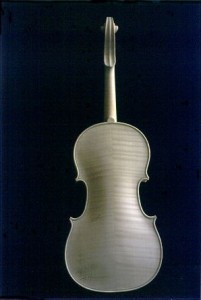
ebony is used for the fingerboard and next rosewood, Snakewood, Olivenholz and also Buxbaum
vertebra, End head / Spine, Out- and tailpiece. The natural resins shellac, Snderk, Mastix, benzoin, Gummigutti inter alia, be used for the lacquer preparation, dissolve in pure alcohol or balsamic turpentine. They are a beef or Fehnhaar (squirrel) Brush in many individual layers on thin- carried.
Strings are made of sheep intestines or student instruments made of plastics which with metal, for longer life, are wound. Fernambuk- or brazilwood bow making takes place in addition to Ebony, Snakewood,Mamutbein, metal
(Gold, Silver and nickel silver), Leather and natural horsehair application. By rosin the bow receives the necessary “Spice” to put the strings in motion.
 No matter what, a violin, viola or a cello, they are all made out of natural materials. The hard wood maple is the basic material used as back, rips and neck of an Instrument. Spruce is the wood responsible for resonance and sound. Therefore it´s used for the tables with the sound-holes (ff-holes), bass bars, soundposts and reinforcements such as linings and blocks. Ebony is used for the fingerboards and besides rosewood, snakewood, olive and boxwood you can find it as pegs, endbutton / ENDPIN, chinrest and tailpieces. The natural resins shellac, sandarac, gum mastic, benzoin, gum-gutti are dissolvable in pure alkohol or balm turpentine.They are put on in thin layers as varnish woth cattle- or sqirrelhair brushes.
No matter what, a violin, viola or a cello, they are all made out of natural materials. The hard wood maple is the basic material used as back, rips and neck of an Instrument. Spruce is the wood responsible for resonance and sound. Therefore it´s used for the tables with the sound-holes (ff-holes), bass bars, soundposts and reinforcements such as linings and blocks. Ebony is used for the fingerboards and besides rosewood, snakewood, olive and boxwood you can find it as pegs, endbutton / ENDPIN, chinrest and tailpieces. The natural resins shellac, sandarac, gum mastic, benzoin, gum-gutti are dissolvable in pure alkohol or balm turpentine.They are put on in thin layers as varnish woth cattle- or sqirrelhair brushes.
Strings can consist of plain gut (sheep intestines), gut wound with metal (less likely to break),
synthetic cor wound with metal steel wound with steel (for undersize instruments). Materials like Fernambuk or Brazilwood in addition to ebony, snakewood, mammothbone, metal (gold, silver, german silver), leather and of course hair are important in the field of bow-making. And finally you need rosin to make the bow work.